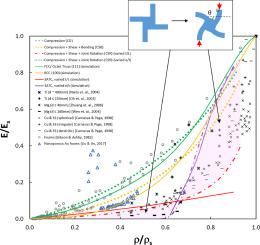International Journal of Mechanical Sciences ( IF 7.1 ) Pub Date : 2021-02-17 , DOI: 10.1016/j.ijmecsci.2021.106353 Chang Quan Lai , Ian Seetoh

|
Powder compaction is an important technique for fabricating engineering materials as it offers good resolution and is compatible with complex stoichiometry and geometries. It forms the basis of important manufacturing processes such as powder bed 3D printing, powder metallurgy and metal injection moulding. However, a major disadvantage is that the presence of porosity in the resultant material can lead to a drastic deterioration of its mechanical properties. To improve the stiffness and strength of these powder compacts, it is imperative to pinpoint the main cause of these weakening effects. Here, we attempt to do so by examining the mechanics of different topologies that the microstructures of powder compacted materials can adopt. General structure – property relationships were first derived for (i) compression/ stretch – dominated (CD) (ii) compression, shear and bending (CSB) and (iii) compression, shear and joint rotation (CSR) topologies, for the range of relative densities between 0 and ~ 0.9. Using the Face-Centered Cubic (FCC), Body-Centered Cubic (BCC) and 3D Anti-Tetrachiral (3ATC) geometries to represent the CD, CSB and CSR topologies respectively, the analytical and simulated relative stiffness vs. relative density and relative strength vs. relative density trends were compared against experimental data in the literature. It was found that the mechanical properties of powdered materials typically fall within an exclusive range of values exhibited by the 3ATC lattice, which is much lower than that expected of FCC and BCC lattices. A closer examination of the analytical equations indicated that the low modulus of 3ATC lattices and powder compacted materials is caused by joint (i.e. particulate) rotation, while their weak strength is the result of thin beams, which manifest as narrow neck-like interparticle connections in powder compacted materials. These results are supported by previous studies, which showed that powder compacted materials have eccentric microstructures similar to 3ATC unit cells and the compression of granular material usually results in extensive particulate rotations. Higher coordination number of the particles is expected to reduce these rotations, thus illuminating the strategy for improving the modulus of powder compacted materials. The material strength, on the other hand, has already been shown to improve with a thickening of the neck regions, which can be achieved through higher sintering temperature, compressive pressure and/ or longer compaction time.
中文翻译:

微观结构拓扑对粉末压实材料力学性能的影响
粉末压实是制造工程材料的一项重要技术,因为它具有良好的分辨率,并且与复杂的化学计量和几何形状兼容。它构成了重要制造工艺的基础,例如粉末床3D打印,粉末冶金和金属注射成型。但是,主要缺点是所得材料中存在孔隙会导致其机械性能急剧下降。为了提高这些粉末压块的刚度和强度,必须查明这些削弱作用的主要原因。在这里,我们尝试通过检查粉末压实材料的微观结构可以采用的不同拓扑结构的力学来做到这一点。首先,针对以下范围推导了一般结构-属性关系,即(i)压缩/拉伸-主导(CD)(ii)压缩,剪切和弯曲(CSB)和(iii)压缩,剪切和关节旋转(CSR)拓扑。相对密度在0到〜0.9之间。使用面心立方(FCC),体心立方(BCC)和3D反四手征(3ATC)几何分别表示CD,CSB和CSR拓扑,分析和模拟的相对刚度与相对密度和相对强度相对密度相对趋势与文献中的实验数据进行了比较。已经发现,粉末材料的机械性能通常落在3ATC晶格所显示的唯一值范围内,该值范围远低于FCC和BCC晶格所期望的值。即微粒)旋转,而它们的强度弱是薄的梁,结果,其表现为窄颈状粉末压实材料间的连接。这些结果得到以前的研究的支持,这些研究表明粉末压实的材料具有类似于3ATC晶胞的偏心微结构,而粒状材料的压缩通常会导致广泛的颗粒旋转。期望更高的粒子配位数减少这些旋转,从而阐明了提高粉末压实材料模量的策略。另一方面,已经证明材料强度随着颈部区域的增厚而提高,这可以通过更高的烧结温度,压缩压力和/或更长的压实时间来实现。











































 京公网安备 11010802027423号
京公网安备 11010802027423号